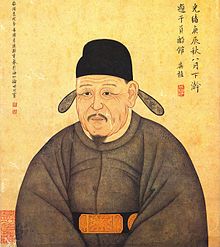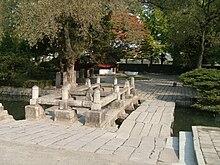This article may require cleanup to meet Wikipedia's quality standards. The specific problem is: Grammar, encyclopedic style. (October 2023) |
Chŏng Mong-ju (Korean: 정몽주; Hanja: 鄭夢周, January 13, 1337 – May 4, 1392[a]), also known by his art name P'oŭn (포은), was a Korean statesman, diplomat, philosopher, poet, calligrapher and reformist of the Goryeo period. He was a major figure of opposition to the transition from the Goryeo (918–1392) to Joseon (1392–1897) periods.
| Chŏng Mong-ju | |
 | |
| Korean name | |
|---|---|
| Hangul | 정몽주 |
| Hanja | 鄭夢周 |
| Revised Romanization | Jeong Mongju |
| McCune–Reischauer | Chŏng Mongju |
| Art name | |
| Hangul | 포은 |
| Hanja | 圃隱 |
| Revised Romanization | Poeun |
| McCune–Reischauer | P'oŭn |

Being the last great personality from the late Goryeo period, exceptional in all aspects of academics, diplomacy, economics, military and politics, and trying to reform Goryeo while maintaining the declining kingdom, he opposed to the Goryeo general Yi Sŏng-gye (the first king of the future Joseon Dynasty) who was a radical revolutionary against the rotten Goryeo Dynasty. Due to his loyalty to Goryeo, Chŏng Mong-ju was eventually assassinated by five men of Yi Pang-wŏn (the fifth son of Yi Sŏng-gye and the third king of Joseon Dynasty).
Biography
editChŏng Mong-ju was born in Yeongcheon, Gyeongsang Province to a family from the Yeonil Jeong clan (연일 정씨; 延日 鄭氏). He was the eldest of five siblings.
At the age of 23, he took three different civil service literary examinations (gwageo) and received the highest marks possible on each of them.[1] In 1367, he became an instructor of Neo-Confucianism at the Gukjagam, then called Songgyungwan, whilst simultaneously holding a government position, and was a faithful public servant to King U. The king had great confidence in his wide knowledge and good judgment, and so he participated in various national projects and his scholarly works earned him great respect in the Goryeo court.
In 1372, Chŏng Mong-ju was sent as a diplomatic envoy to the Ming Dynasty. Around this time, because the Waegu (왜구; 倭寇 - the Japanese pirates) invasions of the Korean Peninsula were extreme, in 1377 Chŏng Mong-ju was dispatched as a delegate to Kyūshū in Japan.[1][2] His negotiations led to promises of Japanese aid in defeating the pirates. At this time, the tandai of Kyūshū, Imagawa Sadayo, made several repressions against the Waegu, probably as a direct result of Chŏng Mong-ju's diplomacy. There is a reason to believe that Sadayo and Chŏng negotiated directly, as later, Sadayo lost his position due to unlawful negotiations with Goryeo.[3] Chŏng Mong-ju traveled to the Ming Dynasty's capital city in 1384[4] and the negotiations with the Chinese led to peace with the Ming Dynasty in 1385. He also founded an institute devoted to the theories of Confucianism.
Chŏng Mong-ju had originally been a moderate supporter of Yi Sŏng-gye and supported his take-over of the court after the Wihwado Retreat from 1388. Although initially supporting some of Yi's moderate reforms, Chŏng soon realized that Yi and some of his more radical supporters, such as Chŏng To-jŏn and Cho Chun, were planning to establish a new dynasty. Due to Chŏng Mong-ju's strong Neo-Confucian beliefs, he was a staunch Goryeo loyalist and opposed any attempts to end the Goryeo Dynasty and found a new one, calling it an immoral act to do so.[5][6]
On April 9, 1392, Yi Sŏng-gye was seriously injured in a horse-back riding accident. Chŏng planned to use this opportunity to destroy Yi's faction. When Yi Pang-wŏn (later Taejong of Joseon), the fifth son of Yi Sŏng-gye, managed to bring back his father to the capital from site of the accident, Chŏng became unsure of the true extent of Yi Sŏng-gye's injuries. On April 26, Chŏng went to Yi's residence to assess the extent of his injuries. During a banquet held for Chŏng, he and Yi Pang-wŏn exchanged poems. Yi Pang-wŏn recited a poem (Hayeoga, 하여가 / 何如歌) to dissuade Chŏng Mong-ju from remaining loyal to the Goryeo Dynasty, but Chŏng Mong-ju answered with another poem (Dansimga, 단심가 / 丹心歌) that affirmed his strong loyalty. As a result, on his way home, Chŏng Mong-ju was assassinated on the Sonjuk Bridge in Gaeseong, by five of Yi Pang-wŏn's subordinates.[7][8] Yi Sŏng-gye is said to have lamented Chŏng Mong-ju's death and rebuked his son, because Chŏng Mong-ju was a highly regarded politician by the common people. The bridge where Chŏng Mong-ju was murdered, nowadays in North Korea, has now become a national monument of the country. A brown spot on one of the stones is said to be Chŏng Mong-ju's bloodstain and is said to become red whenever it rains. Currently, his direct surviving descendants are his 28th – 36th generation, who reside all over the world.[like whom?]
The 474-year-old Goryeo Dynasty symbolically ended with Chŏng Mong-ju's death and was followed by the Joseon period for 505 years (1392–1897). Chŏng Mong-ju's noble death symbolizes his faithful allegiance to the king and Goryeo, and later he was venerated even by Joseon monarchs. Chŏng Mong-ju's murderer, Yi Pang-wŏn (later Taejong of Joseon), inscribed the words "Defender of Goryeo" on his tombstone to praise his loyalty.[9] In 1517, 125 years after his death, he was canonized into Sungkyunkwan (the National Neo-Confucian Academy) alongside, in time, of other Korean sages such as Yi Hwang (Toegye, 1501–1570) and Yi I (Yulgok, 1536–1584).[10] His grave is located in Yongin, Gyeonggi Province, and he was buried next to his wife.[11]
The 11th pattern of ITF Taekwondo is named after P'oŭn. The pattern is performed as part of the testing syllabus for the level of 2nd-degree black belt. The diagram ( — ) represents Chŏng Mong-ju's unerring loyalty to his king and his country towards the end of the Goryeo Dynasty.
The poems
editYi Pang-wŏn's sijo (poem) - Hayeoga (하여가 / 何如歌)
edit이런들 어떠하리 저런들 어떠하리 此亦何如彼亦何如。 (차역하여피역하여)
만수산 드렁칡이 얽어진들 어떠하리 城隍堂後垣頹落亦何如。 (성황당후원퇴락역하여)
우리도 이같이 얽어져 백년까지 누리리라 我輩若此爲不死亦何如。 (아배약차위불사역하여)
(Based on the Hanja)
What shall it be: this or that?
The walls behind the temple of the city's deity has fallen* - shall it be this?
Or if we survive together nonetheless - shall it be that?
(* Yi Pang-wŏn is declaring the death of the Goryeo Dynasty's era.)
Chŏng Mong-ju's sijo (poem) - Dansimga (단심가 / 丹心歌)
edit이몸이 죽고 죽어 일백 번 고쳐 죽어 此身死了死了一百番更死了。 (차신사료사료일백번갱사료)
백골이 진토되어 넋이라도 있고 없고 白骨爲塵土魂魄有也無。 (백골위진토혼백유무야)
임 향한 일편 단심이야 가실 줄이 있으랴 向主一片丹心寧有改理也歟。 (향주일편단심유개리여)
Though I die and die again a hundred times,
That my bones turn to dust, whether my soul remains or not,
Ever loyal to my Lord, how can this red heart ever fade away?
Books
edit- P'oŭn chip (포은집; 圃隱集)
- P'oŭn sigo (포은시고; 圃隱詩藁)
Family
edit- Father
- Chŏng Un-gwan (정운관; 鄭云瓘; 1311–1355)
- Mother
- Grand Princess Consort Pyŏn of the Yeongcheon Yi clan (변한국대부인 영천 이씨; 1313–1365)
- Siblings
- Younger brother - Chŏng Kwa (정과; 鄭過; 1339–1392)
- Younger brother - Chŏng Hu (정후; 鄭厚; 1341–?)
- Younger brother - Chŏng To (정도; 鄭蹈; 1343–?)
- Younger sister - Lady Chŏng (정씨; ?–1400)
- Wife and children
- Princess Gyeongsun of the Gyeongju Yi clan (경순택주 경주 이씨; 敬順宅主 慶州 李氏; 1337–December 12, 1392)
- Son - Chŏng Chong-sŏng (정종성; 鄭宗誠; 1374–1442)[12]
- Son - Chŏng Chong-bon (정종본; 鄭宗本; 1377–1443)
- Daughter - Lady Chŏng (정씨; 1377–?)
- Daughter - Lady Chŏng (정씨; 1388–?)
- Daughter - Lady Chŏng (정씨; 1390–?)
- Princess Gyeongsun of the Gyeongju Yi clan (경순택주 경주 이씨; 敬順宅主 慶州 李氏; 1337–December 12, 1392)
- Concubine and children
- Unnamed concubine (1341–?)
- Son - Chŏng Chong-hwa (정종화; 1375–?)[13]
- Son - Chŏng Chong-ham (정종함; 1377–?)
- Daughter - Lady Chŏng (정씨; 1390–?)
- Unnamed concubine (1341–?)
In popular culture
edit- Portrayed by Hong Gye-il in the 1983 MBC TV series The King of Chudong Palace.
- Portrayed by Park Joon-hyuk in the 2012–2013 SBS TV series The Great Seer.
- Portrayed by Im Ho in the 2014 KBS1 TV series Jeong Do-jeon.
- Portrayed by Kim Eui-sung in the 2015 SBS TV series Six Flying Dragons.
- Portrayed by Choi Jong-hwan in the 2021–2022 KBS1 TV series The King of Tears, Lee Bang-won.
See also
editNotes
edit- ^ In the Korean calendar (lunisolar), Chŏng Mong-ju was born on December 22, 1337 and died on April 4, 1392.
References
edit- ^ a b 정몽주 鄭夢周 Archived 2011-06-10 at the Wayback Machine (in Korean). Nate / Encyclopedia of Korean Culture.
- ^ Titsingh, (1834). p. 313.
- ^ Ōta, Kōki, Wakō: nihon afure katsudōshi (Bungeisha, 2004). p. 98 (太田弘毅『倭寇: 日本あふれ活動史』) (in Japanese).
- ^ Kang, p. 159.
- ^ Chung, Edward Y. J. (January 1, 1995). The Korean Neo-Confucianism of Yi T'oegye and Yi Yulgok: A Reappraisal of the 'Four-Seven Thesis' and its Practical Implications for Self-Cultivation. SUNY Press. pp. 9–10. ISBN 978-0-7914-2275-5.
- ^ Yu, Chai-Shin (2012). The New History of Korean Civilization. iUniverse. p. 126. ISBN 978-1-4620-5559-3.
- ^ Committee, Association for Asian Studies Ming Biographical History Project; Goodrich, Luther Carrington (1976). Dictionary of Ming Biography, 1368–1644. Columbia University Press. p. 1594. ISBN 978-0-231-03833-1.
- ^ Tennant, Roger (November 12, 2012). A History Of Korea. Routledge. p. 129. ISBN 978-1-136-16705-8.
- ^ Peterson, Mark (April 2023). "Lessons from Jeong Mong-ju". Retrieved August 27, 2023.
- ^ Deuchler, Martina (2015). Under the ancestors' eyes: kinship, status, and locality in premodern Korea. Cambridge (Massachusetts): Harvard University Asia Center. p. 76. ISBN 978-0-674-50430-1.
- ^ 정몽주 선생 묘. terms.naver.com (in Korean). Retrieved 2021-06-08.
- ^ His illegitimate daughter became a concubine for Han Myeong-hoe
- ^ His only child and daughter became a concubine to Han Myeong-hoe along with his half-niece
Sources
edit- Kang, Jae-eun; Lee, Suzanne (translator). (2006). The Land of Scholars: Two Thousand Years of Korean Confucianism. Paramus, New Jersey: Homa & Sekey Books. ISBN 978-1-931-90737-8; OCLC 60931394.
- Titsingh, Isaac. (1834). Annales des empereurs du Japon (Nihon Ōdai Ichiran). Paris: Oriental Translation Fund of Great Britain and Ireland. OCLC 84067437.